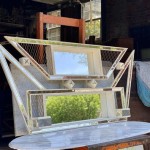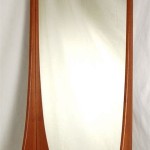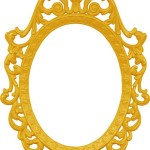Antique Handheld Mirrors: A Reflection of History and Craftsmanship
Antique handheld mirrors offer a fascinating glimpse into the past, reflecting not only the image of their former owners but also the artistry and social values of bygone eras. These delicate objects, crafted from various materials and adorned with intricate details, serve as tangible links to history, representing both personal adornment and evolving craftsmanship.
The history of handheld mirrors stretches back centuries. Early examples, crafted from polished obsidian, bronze, or other metals, were prized possessions in ancient civilizations. As glassmaking technology advanced, glass mirrors became more prevalent, though still reserved for the wealthy due to the intricacies of production. The quality of the glass and the reflective backing often dictated the clarity of the image, impacting the mirror's value and desirability.
The evolution of handheld mirrors is closely intertwined with advancements in materials and manufacturing techniques. Early mirrors frequently employed a backing of polished metal, such as silver or tin, which provided a reflective surface. Later, a process known as silvering, involving the application of a thin layer of silver to the back of the glass, revolutionized mirror production, resulting in clearer and brighter reflections. This process, refined over time, became the standard for high-quality mirrors.
The styles and designs of antique handheld mirrors varied significantly across different periods and cultures. Victorian-era mirrors, for example, often featured ornate frames crafted from materials like silver, ivory, or mother-of-pearl, reflecting the era's opulence and attention to detail. Art Nouveau mirrors embraced flowing lines and natural motifs, showcasing the artistic sensibilities of the late 19th and early 20th centuries. Art Deco mirrors, on the other hand, favored geometric shapes and bold designs, reflecting the modern aesthetic of the 1920s and 1930s.
The materials used in the construction of antique handheld mirrors provide valuable clues to their age and origin. The type of glass itself can be indicative of a particular period. Early glass often exhibits slight imperfections or bubbles, while later glass tends to be clearer and more uniform. The frame materials, ranging from precious metals and gemstones to wood and enamel, can also help determine the mirror's age and value. Marks and hallmarks on metal frames can further assist in identifying the maker and the period of production.
Collecting antique handheld mirrors requires careful consideration and research. Examining the quality of the glass, the intricacy of the frame, and the overall condition of the mirror can provide insights into its authenticity and value. Understanding the stylistic characteristics of different periods and recognizing the materials used in construction are crucial for informed collecting. Reputable antique dealers and auction houses can offer expert guidance and authentication services.
Caring for antique handheld mirrors necessitates gentle handling and appropriate storage. Avoid harsh chemicals and abrasive cleaners, opting instead for a soft, dry cloth to remove dust and fingerprints. Store mirrors in a stable environment, away from extreme temperatures and humidity fluctuations. Protecting fragile frames from bumps and scratches is essential for preserving their original condition.
Beyond their functional purpose, antique handheld mirrors offer a window into the social and cultural context of their time. They reflect the fashion trends, beauty ideals, and artistic sensibilities of past generations. The decorative elements often incorporated into the frames, such as mythological figures, floral motifs, or intricate engravings, provide insights into the symbolic language and cultural narratives of the era.
The size and shape of antique handheld mirrors also varied, reflecting their intended use. Small, compact mirrors were designed for portability and personal grooming, while larger mirrors, often with elaborately decorated stands, served as decorative objects within the home. Some mirrors were specifically designed for travel, featuring folding handles and protective cases, reflecting the evolving lifestyles and travel habits of different periods.
The value of antique handheld mirrors is determined by a combination of factors, including age, rarity, condition, materials, and craftsmanship. Mirrors from well-known makers or with documented provenance can command significant prices. However, even more common antique mirrors can hold considerable value due to their historical significance and aesthetic appeal. Consulting with antique appraisers can provide accurate assessments of a mirror's market value.
The study of antique handheld mirrors offers a rich tapestry of historical information, artistic expression, and cultural insights. These objects, often overlooked, provide a unique perspective on the lives and values of those who once held them, reflecting not only their image but also a glimpse into the past.

Antique Hand Mirror Or Vanity French Held Gold Norway

Vintage Antique Silver Plated Handheld Hand Mirror

Vintage Hand Mirror Silver Plated Handheld Ornate Art Nouveau Style Photo Prop Silverplated Parlor Vanity Decor

Vintage Hand Held Mirror Stock Photo By Ajafoto 9538013

3d Antique Style Handheld Mirror Turbosquid 1294542

Who S The Loneliest Of Them All Hand Mirror Handheld

New Antique Gold Hand Held Mirrors Party Princess Handheld Singapore

Vintage Antique Mini Hand Held Pocket Makeup Vanity Mirror Plastic Silver Small
/product/98/533448/1.jpg?strip=all)
Generic Antique Handheld Mirror With Embossed Rose Pattern For Blue Jumia

Xpxkj Hand Mirror Vintage Handheld With Handle Vanity Makeup Travel Mirrors Oval Rose Gold Wish








